When I first arrived in Vedado, an area of town in Havana, Cuba, my jaw dropped and my brain went into a frenzy trying to figure out why there were so many astounding mansions everywhere, and why in the hell they were all crumbling. There was literally block after block of the most opulent architecture that boasted styles from the colonial and baroque eras in the form of massive homes.
“Who in the hell lives here?!” I wondered at first, before quickly correcting my thought to the more realistic question — “Who in the hell USED to live here?!”.
I still can’t decide if I feel sad, agitated, or angry about the mansions in Cuba. Their pre-Revolution past makes me mad, their post-Revolution past makes me sad, and their current crumbling states makes me beyond irritated.
You see, these magnificent mansions are not like the well kept ones you’d see anywhere else in the world. These mansions have been unwillingly un-kept for the past seventy years, because some people thought it would be a good idea to eliminate a class system. To be fair, it was because some other people thought it was Ok to build mansions and destroy the Cuban economy, but either way, everything has led to the decrepit, crumbling appearance of most of these once majestic mansions.
It took me a few days to learn fully from the locals in Vedado what was going on, plus a few death stares when I tried to nonchalantly stroll into the open doors of a few of them, but here it is in simple terms, the reason why all the mansions in Cuba are crumbling.
Jump To:
Cuba Was Corrupt in the 1950’s, Largely Due to the U.S. Citizens Who Came and Made it Their Carribean Playground — Havana Was Considered Then What Las Vegas Has Become Now.
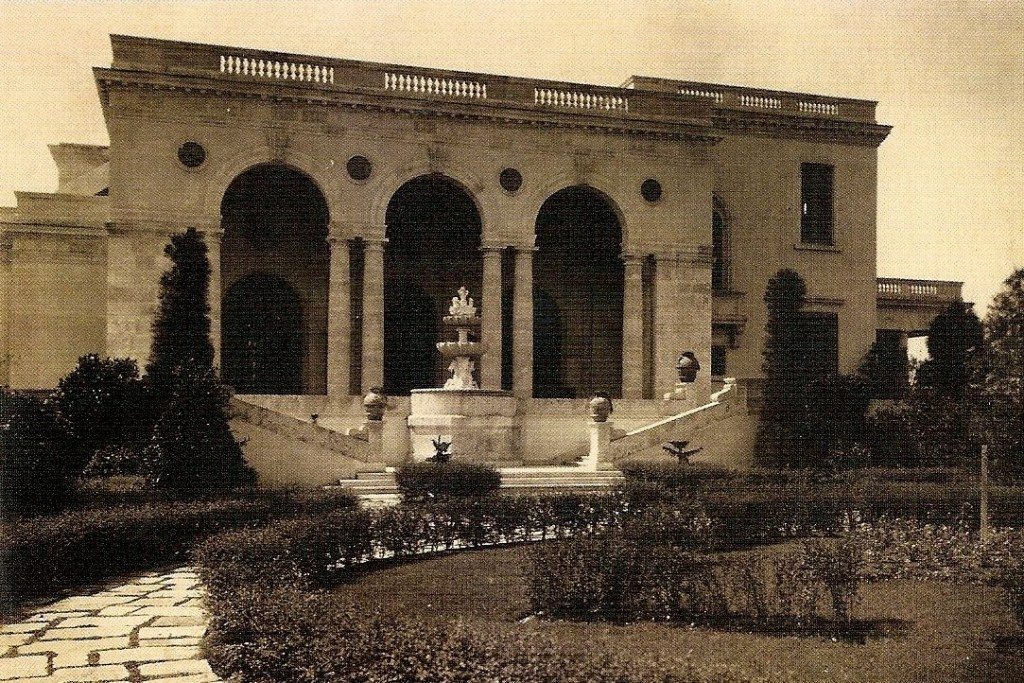
Money came pouring into Havana as the tourists would spend loads on entertainment and gambling, which would eventually lead to the rapid uprise of drugs and prostitution. In fact, one local told me that, “In the 1950’s, you could get cocaine as easily as you could get a beer…just a lot more expensive.”
Soon that was all that Havana was known for; gambling, drugs, and prostitution. While money was abundant in the city of sins, the rest of the Cuban economy was severely weakened as a result of the U.S. influence.
So who were these rich assholes who lived in the mansions?
Mafia, Mob, and Gang Leaders, Plantation Owners, Government Leaders, and Celebrities All Had Mansions in Havana in the 1950’s

So to answer the question of who lived in the mansions when they were actually nice mansions…the rich people from the United States who could afford to build such monumental monstrosities.
So where did they all go, you ask?
Fidel Castro Took Over The Government, With The Idea That Everyone Would Be Equal

In January of 1959, Fidel Castro and his army, overthrew Batista (who actually ran away with about $40 mill of government money), and started the Revolution. He immediately put a halt to the gambling and prostitution, which was great for the Cubans, but caused tensions with the U.S.
The Revolutionary leaders despised what Cuba had become, and aimed to eliminate the class system so that everyone would be equal, which is what we like to call “Communism”, and what the U.S. wanted nothing to do with.
So when Castro kicked all of the rich people out of their homes because he wanted everyone to have the same amount of land and money, they all went back to the States, likely assuming the U.S. would do something about him, and that they’d get to go back in a few months and take their mansions back.
But Communism doesn’t work that way.
The U.S. Responds to Castro’s Intolerance By Enacting the Trade and Travel Embargo in 1963

That means that there were no U.S. building materials, equipment, or cars being shipped in from the U.S. after 1963. Sure, they might have been able to find materials from elsewhere, but OH WAIT, Communism made it so that no one could earn more money to buy things they need, like building supplies and furniture.
Let’s take a quick lesson on Communism in Cuba before I continue. Ahem.
Castro’s Communism Made All The Cuban People Earn the Same Amount, Eat the Same Amount, and Have the Same Amount, Despite Their Professions

Imagine being a doctor and being paid the same amount as a plumber. That’s what Communism did for the Cuban people after the resolution. Every Cuban person makes the same amount of money (about $40 a month). So how do they pay rent and buy food? I asked this a thousand times, so now I know. For food, the families get “ration cards” that allows them a certain amount of food each week. Once you turn six years old, you no longer get as much meat, and you aren’t allowed to get more than your rations.
School is free, even though English is not taught, and so is medical care, and utilities.
But here’s the catch — rent is also free, so my major question was…
How the hell some people got lucky and got to live in the mansions?!
Housing Was Determined by Family Size, and Ancestry

No, there wasn’t a lottery with one lucky family winning a brand new former-druglord’s mansion. The government assessed everyone, and placed them in homes according to family size, and who their ancestors were. Families with government leaders or notable people obviously got the nicer homes, like the mansions, but the government decided it was still too much space for just one family to have.
That’s why you’ll see multiple families living in these mansions, some upstairs, some downstairs, and some I don’t even know where else. This was why my cousin Pupi got kicked out of my grandmother’s family house in Santiago de Las Vegas – because she was living there alone, so they moved a family in instead.
I’m sure it was somewhat nice for the people who got the mansions back when they were new. But guess what happens to enormous mansions when multiple people live in them, and no one can afford to maintain them?
Time, and Communism Took a Toll on the Mansions, and Now They Are All Crumbling in Cuba
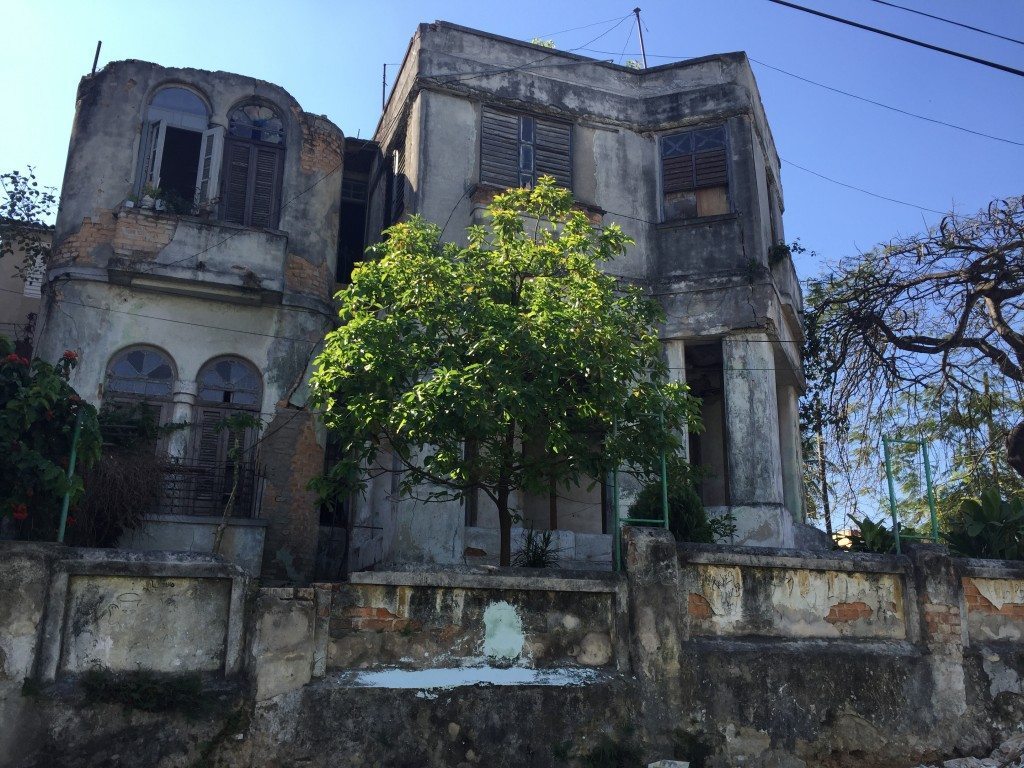
Everyone says, “Cuba is like a time-capsule”, and “It’s so cool how well preserved Cuba is”. But tell that to the people who involuntarily couldn’t take care of their homes, to restore them to a more current state.
The families are literally sleeping on rubble, and the insides of some of the homes have almost completely collapsed. Vines and mold surround the outsides of most of them, and the once beautiful balconies, now support rows of clotheslines.
Some have recently been restored, but they are owned by embassies, institutions, or the government. For the most part, the mansions still remain the homes of the Cuban families who were placed there 70 years ago.
So what’s going to happen next for the crumbling mansions? And no, you cannot just go to Cuba and buy one to restore it.

Lifting the Embargo Will Bring Goods to the Families, Many of Which Convert Their Homes to Paladores or Casa Particulars
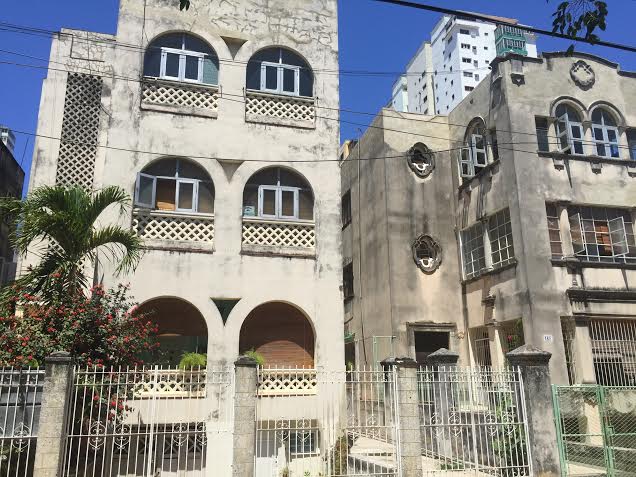
I stayed in a Casa Particular, which means a house that has been turned into a place that rents out rooms to tourists. The woman told me her children live in the U.S., and brought things over for her to convert her home into a sort of bed and breakfast. This is one of the only ways for Cubans to make more money than they do at their jobs. They are allowed to profit from renting their homes, as long as they pay about 20% tax to the government.
You can tell that multiple families live in the houses by the ones that are half restored, and half crumbling. That means that one of the families had family that sent them things and the other didn’t.
There are also a lot of Paladores, which translates to “house-restaurant”. Cubans are also allowed to convert all or part of their home into a restaurant, and profit from sales that way as well.
Typically they are in the upper levels of the homes, and the families live downstairs, but I saw one that was set up right on the front yard of one of the biggest mansions I saw.

…in a nutshell.


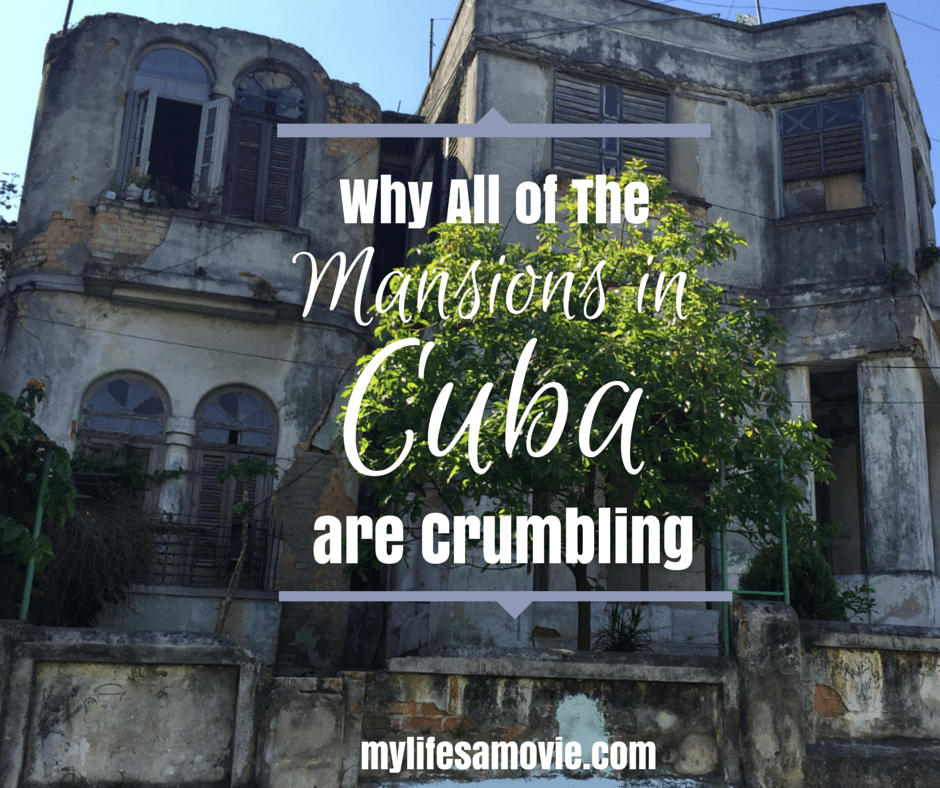
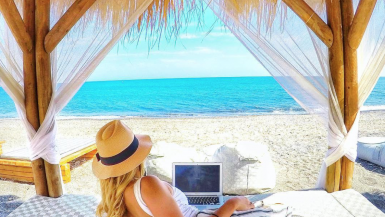
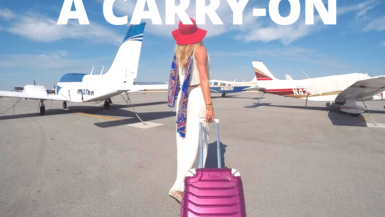
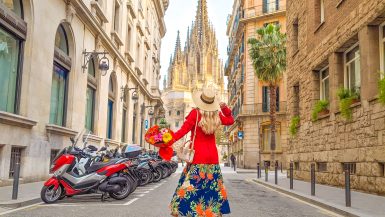
Why are we afraid to say that the destruction of Cuba was caused by communism ???. Can anyone tell me in whick country has communism worked as well as a country under the “free enterprise system ???”
Open your eyes and don’t let the communists (a,k.a, liberals) fool you to believe their stories. Go to Miami and talk to any cuban refugee and let them tell you the “wonders of communism…”
This whole post basically says the cause of the crumbling of mansions was because of the communist takeover and American embargo.
Wonderful article. I am happy to see that you made an error on the bottom picture. That fine old house is on Linea and Presidentes and I am happy to see that it will house a fine Cuban cultural institution. I am soooo happy that important palace will be saved !! <3 <3
What the left fails to realize is that it is through entrepreneurship and capitalism that peoples’ lives improve, hence the room rentals and restaurants on peoples’ properties. Hillary and Bernie would like to reduce American standards to make things more equal for most, not including themselves.
Just sad and a living example that communism does not work. Not to get political but people living in this fairy tale we will all live like Donald trump or kardashians need to visit and tour Cuba. Its a on my list to go, these photos made me sad but excited for the possibility of changes coming to the country. Thank you for sharing.
This was actually a very informative and interesting read! I’m an architecture and history fan girl, so I wanted to indulge on Cuba’s pre-Castro influences when I go next week. Can’t wait to explore!
What a great post. People don’t realized the history and the stories behind every houses and buildings in any country. Thank you for providing the insights on Cuban people and the struggle they faced, I truly hope that the future for Cuba will be better with the economy and the uplifting, allowing them to rebuild and restore their culture.
Being from Miami, I’ve grown up surrounded by people of Cuban decent. I know many people who now have a chance to visit family who they have not seen in years, or who now have a chance to step foot in Cuba for the first time. I really hope that lifting the embargo will help the island to rebuild and that the people will once again be able to care for their homes.
This is really interesting, I’ve never been to Cuba, and the images that I do get to see are just the main all-inclusive tourist places. I’d never considered where the ordinary Cubans lived, but now I know. I love reading stuff like this – thank you so much!
What a fascinating post Alyssa! While they might look interesting from a tourist perspective I’m sure those that are living in Cuba would much rather have them restored to their former glory. I look forward to visiting Cuba sometime soon!
It would be great to see the mansions restored to their former grandeur while at the same time seeing the economy of the locals improves. Hopefully down the road, they’d still retain the current charm of the city & country that so many people who have been there in recent years talk about.
Such an interesting post! I’m ashamed to admit I didn’t know much history behind Cuba. I love that you are helping travelers to see things from the side of the locals rather than, “Yeah, Cuba is a cool place to visit because it’s great for photos.”
I find it really interesting that, even when presented with evidence such as this super assessment on your part, people would still extol the virtues of egalitarian political systems. In theory, it’s wonderful, but as you say, imagine yourself a doctor earning 40 bucks a month just like everyone else. And then, imagine if you’ve got government connections so you get a nicer place to live. Every single time similar societies have been implemented, there has still been an elite class with a huge divide. Obviously, it’s all far too complicated to solve in the space of a post or a comment, but your post is the most thoughtfully provocative of all the ones I’ve seen since the embargo was lifted. Bravo.
I don’t know what the lifting will bring for Cuba, but you make a good point about Cubans being able to see their families in the US and vice-verse.
Cuba is a dear place to my heart. As a Canadian, I’ve visited many times and my parents did business in Cuba when I was a child. I always loved the people, the environment and the safety. I hope that never changes. 🙂
I was there for 18 days in Jan/Feb….it’s safe as ever and there are people all around the island discovering it. If you want to head into the country, there are rental houses everywhere. It’s so different than just a decade ago !
Alyssa, thank you for sharing the story of the crumbling mansions in Cuba – I did not know much about the history of Cuba but I now have a much better appreciation.
What an interesting, thought-provoking inside look at Cuba. Those crumbling mansions do tell the whole story!
Cuba seems to me to still be such a seperate ecosystem compared to the rest of the world. Thank you for sharing your insights on this concluded part of the world.
What a great article. I went to Cuba three years ago, and I found the colonial remnants somewhat sad too. Havana is amazing, and a time warp. I just wish I had spent more time exploring, as we were staying in Varadero. This fills in a gap for me, thank you.